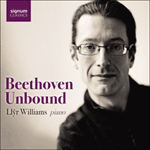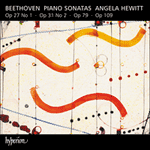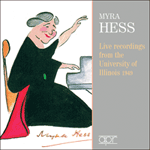
Welcome to Hyperion Records, a British classical label devoted to presenting high-quality recordings of music of all styles and from all periods from the twelfth century to the twenty-first.
Hyperion offers both CDs, and downloads in a number of formats. The site is also available in several languages.
Please use the dropdown buttons to set your preferred options, or use the checkbox to accept the defaults.

The first movement changes tempo markings four times in the opening eight bars. Beethoven begins Largo, with a rolled chord and the right hand slowly completing the full arpeggio. It is not, however, the expected D minor chord, but rather A major—the dominant key. And, to make things even more tentative, a first inversion of the chord at that: the kind of chord that harpsichordists give when introducing a recitative in a classical opera. After three bars in Allegro, which introduce a two-note figure full of worry and haste, he changes to Adagio for the cadence in A major. Out of the blue then comes the same inverted rolled chord, this time in C major. The ensuing passage on the two-note figure ratchets up the excitement considerably—rising, falling, becoming insistent—before finally, in bar 21, landing incontestably in D minor.
It is tempting to consider the first twenty bars as only an introduction, and not thematically important. But on closer examination, you can see that the theme introduced so emphatically in the left hand in bar 21 is none other than the right hand of the opening, completely transformed. You could even go so far as to consider the response to that angry left hand, uttered softly by the right while the tremolo accompaniment continues, as an augmented and inverted version of the turn in bar 6. In any case, it must all be made to hang together as one piece. On the practical side, the person learning it has to decide what to do at the end of bar 22: take the mournful melody in the top line with the right hand or the left? I take it with the left, silently grabbing the long pedal note in the bass with the right hand once I’ve struck it with the left. Not easy, but for me the most satisfying solution both musically and technically.
The music then rises in steps, becoming more insistent with each one. In bar 41 it drops to piano, but you can feel the worry and agitation in the music that Beethoven asks the fingers to play. The turn figure that has also been present in the whirling left-hand accompaniment is now presented forcefully, but the exposition itself doesn’t end with a bang. A sorrowful descending four-note motif, taken from the outline of bar 3, enters over and also under constant quavers, before being presented in unison just before the double bar. This ends up being a direct quote from the aria ‘Es ist vollbracht’ from Bach’s St John Passion.
Those improvisatory slow arpeggios return at the beginning of the development section, and also in the middle of it, heralding one of the most haunting moments in all of the sonatas. Here Beethoven finally does give us that recitative, asking it to be played con espressione e semplice and, according to Czerny, with the pedal held throughout. The second one, with the penetrating D flat after the C major chord, is especially poignant.
When the Allegro returns, the staccato chords, articulated by rests, are full of suspense. This astounding movement ends with ‘distant thunder’, as Czerny called it, rumbling in the distance, foreshadowing a similar end to the first movement of his ‘Appassionata’ sonata, written a few years later. There is no deliverance for the restless soul.
The second movement, Adagio, is one of Beethoven’s most glorious slow movements (Czerny called it ‘elevated’). Its character is noble, its effect soothing. Like the preceding movement, it also begins with a broken chord, and has a turn as a key element in the melody. And there is still that distant rumbling—this time a drum-like figure that must be played lightly and clearly. The dolce melody that appears in bar 31 I find heartbreaking in its eloquent simplicity. It speaks with infinite tenderness.
The third and final movement enters hauntingly, with a hypnotic theme that is much harder to play than it looks. Do not put the second finger on the second note of the left hand! That is not what Beethoven wrote. You have to skip quickly (and with the minimum amount of movement) to the fourth finger for the tied A. The tempo marking, Allegretto, is not fast. Despite the fact that Beethoven is alleged to have composed this after seeing a man galloping by his window on a horse, excessive speed is not called for. The section beginning at bar 110 shows that Bach was never far from Beethoven’s mind. I think Denis Matthews was right to say that its predominant character ‘is pathetic rather than energetic, the pursued rather than the pursuer, offset by occasional frenzied outbursts’. The tragic feeling continues right to the end, with the music disappearing into the void.
When Anton Schindler, as the story goes, asked Beethoven what this sonata was all about, Beethoven angrily retorted, ‘Read Shakespeare’s Tempest!’ No further explanation was ever forthcoming, but as Schindler was a liar and a forger, one has to take that with a grain of salt. I daresay you could equate certain passages in the sonata with happenings in the play without too much difficulty. What I do feel when performing this personal favourite among the Beethoven sonatas is that it speaks somehow in a different way. The word ‘speak’ is actually crucial: its drama is highly eloquent, yet in the end it all disappears, as Prospero says, ‘into thin air’.
from notes by Angela Hewitt © 2018
Le premier mouvement change d’indication de tempo quatre fois au cours des huit mesures initiales. Beethoven commence Largo, avec un accord largement arpégé que la main droite complète lentement. Toutefois, ce n’est pas l’accord attendu de ré mineur, mais celui de la majeur—la tonalité de la dominante. Et, pour rendre les choses encore plus indécises, c’est sur le premier renversement de l’accord: le genre d’accord que donnent les clavecinistes lorsqu’ils introduisent un récitatif dans un opéra classique. Après trois mesures Allegro, qui introduisent une figure de deux notes pleine de souci et de hâte, il passe à Adagio pour la cadence en la majeur. À brûle-pourpoint vient ensuite le même accord arpégé inversé, cette fois en ut majeur. Le passage en figures de deux notes qui suit augmente beaucoup l’excitation—montant, descendant, devenant insistant—avant de finir par atterrir à la mesure 21, sans le moindre doute en ré mineur.
Il serait tentant de ne considérer les vingt premières mesures que comme une introduction, sans importance sur le plan thématique. Mais en les examinant de plus près, on peut voir que le thème introduit si énergiquement à la main gauche à la mesure 21 n’est rien d’autre que ce que jouait la main droite au début, complètement transformé. On pourrait même aller jusqu’à considérer la réponse à cette main gauche démontée, que profère doucement la droite pendant que l’accompagnement de trémolos continue, comme une version augmentée et inversée du grupetto de la mesure 6. En tout cas, tout doit se tenir. Sur le plan pratique, la personne qui travaille cette œuvre est confrontée à un choix à la fin de la mesure 22: faut-il prendre la mélodie triste de la ligne supérieure à la main droite ou à la main gauche? Je la prends à la main gauche, en gardant silencieusement la longue pédale de basse avec la main droite, après l’avoir attaquée avec la gauche. Pas facile mais, pour moi, c’est la solution la plus satisfaisante sur le plan musical comme sur le plan technique.
La progression musicale s’effectue ensuite par étapes, à chaque fois plus insistante. À la mesure 41, on tombe à une nuance piano, mais on peut sentir l’inquiétude et l’agitation dans la musique que Beethoven demande aux doigts de jouer. La figure de grupetto qui a aussi été présente dans l’accompagnement tourbillonnant de la main gauche est maintenant présentée avec vigueur, mais l’exposition elle-même ne se termine pas avec fracas. Un triste motif descendant de quatre notes, tiré de l’idée de la mesure 3, entre au-dessus et aussi en dessous des croches régulières, avant d’être présenté à l’unisson juste avant la double barre. Ceci finit par être une citation directe de l’aria «Es ist vollbracht» de la Passion selon saint Jean de Bach.
Ces arpèges lents de style improvisé reviennent au début du développement et aussi en son milieu, annonçant l’un des moments les plus envoûtants de toutes les sonates. Ici, Beethoven nous donne enfin ce récitatif, lui demandant d’être joué con espressione e semplice et, selon Czerny, avec la pédale tenue du début à la fin. Le second récitatif, avec le ré bémol pénétrant après l’accord de do majeur, est particulièrement poignant.
Au retour de l’Allegro, les accords staccato, articulés par des silences, sont pleins de suspense. Ce mouvement stupéfiant s’achève avec un «tonnerre distant», comme l’appelait Czerny, grondant au loin, présageant une fin similaire du premier mouvement de la sonate «Appassionata», écrite quelques années plus tard. Pas de salut pour l’âme tourmentée.
Le deuxième mouvement, Adagio, est l’un des plus magnifiques mouvements lents de Beethoven (Czerny le trouvait «élevé»). Il est noble de caractère, avec un effet apaisant. Comme le mouvement précédent, il commence par un accord arpégé et comporte un grupetto comme élément clef dans la mélodie. Et il y a encore ce grondement éloigné—cette fois une figure tambourinante qui doit être jouée avec légèreté et précision. La mélodie dolce qui apparaît à la mesure 31 est pour moi déchirante dans son éloquente simplicité. Elle parle avec une tendresse infinie.
Le troisième et dernier mouvement commence de manière lancinante, avec un thème hypnotique beaucoup plus difficile à jouer qu’il n’y paraît. Il ne faut pas mettre l’index sur la deuxième note de la main gauche! Ce n’est pas ce que Beethoven a écrit. Il faut vite (et avec un minimum de mouvement) sauter au quatrième doigt pour le la tenu. L’indication de tempo Allegretto n’est pas rapide. Malgré le fait que Beethoven soit présumé avoir écrit ce mouvement après avoir vu un homme passer devant sa fenêtre en galopant à cheval, une vitesse excessive n’est pas nécessaire. La section qui commence à la mesure 110 montre que Bach n’était jamais loin de l’esprit de Beethoven. Je pense que Denis Matthews avait raison de dire que son caractère prédominant «est pathétique plutôt qu’énergique, le poursuivi plutôt que le poursuivant, compensé par d’occasionnels emportements frénétiques». L’impression tragique se poursuit jusqu’à la fin, la musique disparaissant dans le néant.
Selon la légende, quand Anton Schindler demanda à Beethoven de quoi traitait cette sonate, Beethoven répliqua avec colère: «Lisez La Tempête de Shakespeare!» Aucune autre explication ne fut jamais avancée, mais comme Schindler était un menteur et un faussaire, il ne faut pas la prendre au pied de la lettre. On pourra sans doute comparer sans trop de difficulté certains passages de la sonate à des événements survenant dans la pièce. Ce que je ressens lorsque je joue cette sonate de Beethoven que j’aime particulièrement, c’est qu’elle parle en fait d’une manière différente. Le mot «parle» est vraiment essentiel: son drame est très éloquent, mais à la fin tout disparaît, comme le dit Prospero, tout «se volatilise».
extrait des notes rédigées par Angela Hewitt © 2018
Français: Marie-Stella Pâris
In den acht Anfangstakten des ersten Satzes kommen vier verschiedene Tempobezeichnungen vor. Beethoven beginnt im Largo mit einem arpeggierten Akkord, der von der rechten Hand langsam vollendet wird. Es handelt sich dabei allerdings nicht um den zu erwartenden d-Moll-Akkord, sondern um A-Dur—die Dominanttonart. Und um das Ganze noch unverbindlicher zu gestalten, erklingt er in der ersten Umkehrung: die Art Akkord, mit der Cembalisten ein Rezitativ in einer klassischen Oper eröffnen. Nach drei Takten im Allegro, in denen eine Zweitonfigur voller Sorge und Hast vorgestellt wird, wechselt er zu einem Adagio, um die Kadenz in A-Dur erklingen zu lassen. Wie aus dem Nichts heraus folgt dann der gleiche umgekehrte Arpeggio-Akkord, nur diesmal in C-Dur. Mit der anschließenden Zweitonfigur-Passage nimmt die Spannung erheblich zu, steigt an, fällt ab, wird hartnäckig, bevor sie schließlich in Takt 21 unanfechtbar in d-Moll landet.
Man ist versucht, die ersten 20 Takte als Einleitung und damit als thematisch unbedeutend zu betrachten. Bei genauerer Untersuchung stellt sich jedoch heraus, dass das Thema, welches in der linken Hand in Takt 21 mit derartigem Nachdruck vorgestellt wird, kein anderes ist, als das der rechten Hand vom Beginn, wenn auch in völlig verwandelter Form. Man könnte sogar so weit gehen und die Antwort auf diese zornige linke Hand, welche sanft von der rechten geäußert wird, während die Tremolo-Begleitung fortfährt, als eine augmentierte und umgekehrte Version des Doppelschlags in Takt 6 zu betrachten. Wie dem auch sei, es muss sich jedenfalls alles zu einem Ganzen zusammenfügen. Seitens der Praxis muss der Ausführende entscheiden, was am Ende von Takt 22 zu tun ist—soll die trauervolle Melodie in der Oberstimme von der rechten oder linken Hand gespielt werden? Ich nehme sie mit der Linken und mache einen stummen Handwechsel auf dem ausgehaltenen Orgelpunkt im Bass (die Linke schlägt ihn zunächst an und dann hält die Rechte ihn weiter aus). Zwar ist das nicht ganz einfach zu meistern, aber für mich die sowohl musikalisch als auch technisch befriedigendste Lösung.
Darauf steigt die Musik stufenweise an und wird jeweils beharrlicher. In Takt 41 fällt sie in ein Piano zurück, doch kann man die Sorge und Erregung in der Musik spüren, die Beethoven den Fingern zu spielen gibt. Die Doppelschlag-Figur, die auch in der umherwirbelnden Begleitung der linken Hand aufgetreten ist, wird nun mit Nachdruck vorgestellt, doch die Exposition selbst endet eher sanft. Ein trauervolles, absteigendes Viertonmotiv, das aus der Silhouette von Takt 3 stammt, setzt sowohl über als auch unter fortlaufenden Achteln ein, bevor kurz vor dem Doppelstrich ein Unisono erklingt. Dieses erweist sich als direktes Zitat aus der Bach-Arie „Es ist vollbracht“ aus der Johannespassion.
Die improvisatorischen, langsamen Arpeggien kehren zu Beginn und auch in der Mitte der Durchführung wieder, wo sie einen besonders eindrucksvollen Augenblick ankündigen, der in Beethovens Sonatenwerk fast einzigartig ist. Hier erklingt endlich jenes Rezitativ, das con espressione e semplice zu spielen sowie, Czerny zufolge, durchweg mit dem Pedal zu halten ist. Das zweite, mit dem durchdringenden Des nach dem C-Dur-Akkord, ist besonders ergreifend.
Wenn das Allegro wiederkehrt, vermitteln die durch Pausen artikulierten Staccato-Akkorde erhebliche Spannung. Dieser erstaunliche Satz endet mit entferntem Donnergrollen, wie Czerny es ausdrückte, womit das ähnliche Ende des ersten Satzes der „Appassionata“ vorweggenommen wird, die einige Jahre später entstand. Die ruhelose Seele findet keine Erlösung.
Der zweite Satz, Adagio, ist einer der allerschönsten langsamen Sätze von Beethoven (Czerny bezeichnete ihn als „erhaben“). Sein Charakter ist nobel, die Wirkung wohltuend. Wie der vorangehende Satz beginnt auch dieser mit einem arpeggierten Akkord und ein Doppelschlag ist ein wichtiges Element der Melodie. Auch das entfernte Grollen macht sich bemerkbar—diesmal eine trommelartige Figur, die leicht und deutlich gespielt werden muss. Die Schlichtheit der Dolce-Melodie, die in Takt 31 erklingt, empfinde ich als herzzerreißend. Sie tritt mit unendlicher Zärtlichkeit auf.
Der dritte und letzte Satz beginnt in bewegender Weise mit einem hypnotischen Thema, das in der Praxis viel schwieriger auszuführen ist, als es auf dem Papier den Anschein hat. Der zweite Finger darf nicht den zweiten Ton in der linken Hand spielen! Das hat Beethoven nicht so geschrieben. Stattdessen muss man schnell (und mit möglichst wenig Bewegung) auf den vierten Finger wechseln, um das herübergebundene A zu spielen. Das Tempo, Allegretto, ist nicht schnell. Obwohl Beethoven diesen Satz angeblich komponierte, nachdem er einen Reiter an seinem Fenster hatte vorbeigaloppieren sehen, ist hier kein übermäßiges Tempo vonnöten. Der Abschnitt, der in Takt 110 beginnt, zeigt, wie sehr Bach ihm gegenwärtig war. Denis Matthews hat wohl recht, wenn er sagt, dass der vorherrschende Charakter hier „eher kläglich als energisch“ sei, „der Verfolgte und nicht der Verfolger, versetzt mit gelegentlichen, ungestümen Ausbrüchen“. Die tragische Note bleibt bis zum Ende erhalten, wenn die Musik in die Leere entschwindet.
Angeblich fragte Anton Schindler den Komponisten, worum es in der Sonate ginge, worauf Beethovens ungeduldige Antwort lautete: „Lesen Sie nur Shakespeares Sturm!“ Weiter ausgeführt wurde diese Bemerkung nie; da Schindler jedoch ein Fälscher war, der zudem mit der Wahrheit oft sparsam umging, muss das Ganze cum grano salis genommen werden. Ich wage zu behaupten, dass gewisse Passagen in der Sonate durchaus mit Ereignissen in dem Stück gleichgesetzt werden können. Wenn ich dieses Werk, meine Lieblingssonate von Beethoven, aufführe, stellt sich mir immer der Eindruck ein, dass es in anderer Weise spricht. Das Wort „sprechen“ ist dabei entscheidend: die Dramatik ist äußerst beredt, doch löst sich am Ende alles, wie Prospero sagt, in Luft auf.
aus dem Begleittext von Angela Hewitt © 2018
Deutsch: Viola Scheffel
 Beethoven: Beethoven Unbound Beethoven: Beethoven UnboundA comprehensive new cycle of the Beethoven sonatas recorded live at London's Wigmore Hall during the pianist's epic fourth rendition of these masterpieces .» More |
 Beethoven: Piano Sonatas Opp 27/1, 31/2, 79 & 109 Beethoven: Piano Sonatas Opp 27/1, 31/2, 79 & 109Angela Hewitt’s next instalment of Beethoven, bookended by the great ‘Tempest’ and late E major sonatas.» More |
 Myra Hess - Live recordings from the University of Illinois, 1949 Myra Hess - Live recordings from the University of Illinois, 1949Two complete recitals recorded at Illinois University on 17 and 18 March 1949 and some bonus recordings originally broadcast on 7 March 1937. Almost all the works included in this programme are new additions to the Myra Hess discography.» More |

